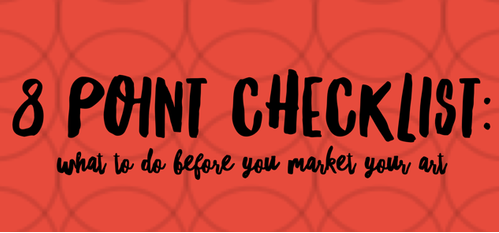by Carolyn Edlund
Want to market and sell your art or handmade work? Review this checklist to make sure you have everything you need to get started.

Evaluate your portfolio.
Is your body of work in a cohesive grouping, well-made and with a strong signature style? Does it reflect your best efforts? Take a critical look at what you plan to show. Weed out anything that doesn’t fit by doing a bit of self-curation. Remove older work that doesn’t reflect your current direction. Eliminate artwork in other mediums that don’t fit well, and may distract from the whole. You will be judged by the weakest piece you show.
Put together an excellent presentation.
Every image of your art or handmade work that is used for marketing purposes should give the impression that you are a professional. Avoid common problems like blurry shots, poor lighting or inappropriate backgrounds in the photos of your work. If your current portfolio needs help, consider hiring a photographer with experience in this area. Or learn how to take great photos yourself.
Know your concept and your story.
What is your art all about, and what inspires you? Is there a bigger concept behind what you do? Why should people care about your art and purchase it? Buying art is more than just acquiring an object; it’s an experience, and your story is an integral part of the sale. The more effectively you convey the concept behind your collection and your own personal story as an artist, the better.
Identify your customer.
Do you know your ideal collector? It’s important to have a good idea about the type of buyer you are trying to attract. This knowledge will influence the branding used in your business and the marketing messages you send. As you get in front of people face-to-face, listen carefully. Observe who is interested, and get feedback from them. The more you know about them, the more easily you can tell your story in a way that matters to them.
Create a compelling marketing message.
Before you can begin your marketing strategy, you should work on writing the all-important content that can best share your art with your audience in a way that emotionally resonates. How will you draw interest in what you do? What is compelling about your art? Use this information to construct marketing messages to use on a consistent basis.
Build an online presence.
When you promote and publicize, your marketing messages should involve a Call to Action. What do you want your audience to do? You might ask them to attend your exhibition, or visit your booth at an art festival. But you also might want them to view your portfolio online, because that presents a 24/7 opportunity to showcase your art. Social media sites are wonderful, but an individual art website is the best way to share your work in a professional way and build credibility as an artist.
Grow your list.
Every business starts small. You may begin with a mailing (or email) list of friends and family as your first foray into marketing. But as you gain exposure, collect the names and contact information of people who are interested in what you do. Why? The simple truth is that you have to send your marketing messages out over time to your list to become memorable to them. Marketing is an ongoing process, and repeat contacts are necessary to close most sales. Put a system into place to create a list of people who will receive your marketing messages.
Construct a plan.
There are many ways to market your art, including advertising, social media, email marketing, and getting press coverage. Before you start, create a thoughtful plan to use marketing channels that make sense for your business, your available time and your budget. Begin a marketing calendar to keep yourself on track. And measure your results to see what’s working and what is not. In that way, you will know whether you are achieving your set goals or need to make adjustments in your plan.
